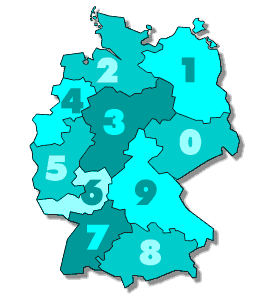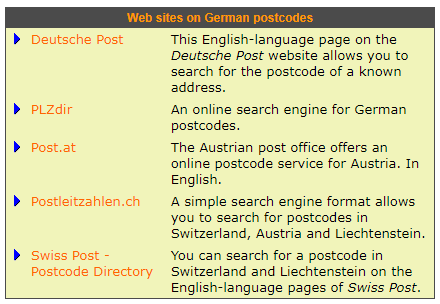Germany pioneered the idea of post codes back in the early sixties, and the rest of the world imitated the concept. The German word for a postcode is "die Postleitzahl (-en)", which is often abbreviated to "PLZ".
The current postcode system was introduced on 1 July 1993 to take account of post-reunification Germany. All addresses now have a five-digit code, with the first two numbers indicating the region and the last three narrowing it down to a specific area of a town or a village. Hence the reason why German addresses are so much shorter than British ones - the postcode supplies all the requisite information. Below is a map showing the regions of Germany to which the first number of the post code corresponds.

Unlike British postcodes, German postcodes precede the name of the place in addresses.
In addition, when writing to one of the German-speaking countries from abroad, people sometimes prefix the postcode with the international country code for the sake of clarity. As Germany has the international country code "D", this produces such postcodes as D-10825 Berlin and D-01069 Dresden.
A similar principle applies when writing from overseas to addresses in the other German-speaking countries. Austria has the international country code "A", Switzerland has "CH" and Liechtenstein "FL". As postcodes in these countries have four digits, this produces such postcodes as A-9010 Klagenfurt, CH-4012 basel or FL-9490 Vaduz.
These international country codes are now however increasingly seen as archaic. The correct convention for addressing international letters is not to prefix the postcode with a country code, but to ensure that the country name is written in capital letters in the language of the origin country on a line of its own at the end of the address - e.g. "10825 Berlin, Deutschland", "9010 Klagenfurt, Österreich", "4012 basel, Schweiz", "9490 Vaduz, Liechtenstein".

 英语
英语 日语
日语 韩语
韩语 法语
法语 西班牙语
西班牙语 意大利语
意大利语 阿拉伯语
阿拉伯语 葡萄牙语
葡萄牙语 越南语
越南语 俄语
俄语 芬兰语
芬兰语 泰语
泰语 丹麦语
丹麦语 对外汉语
对外汉语

